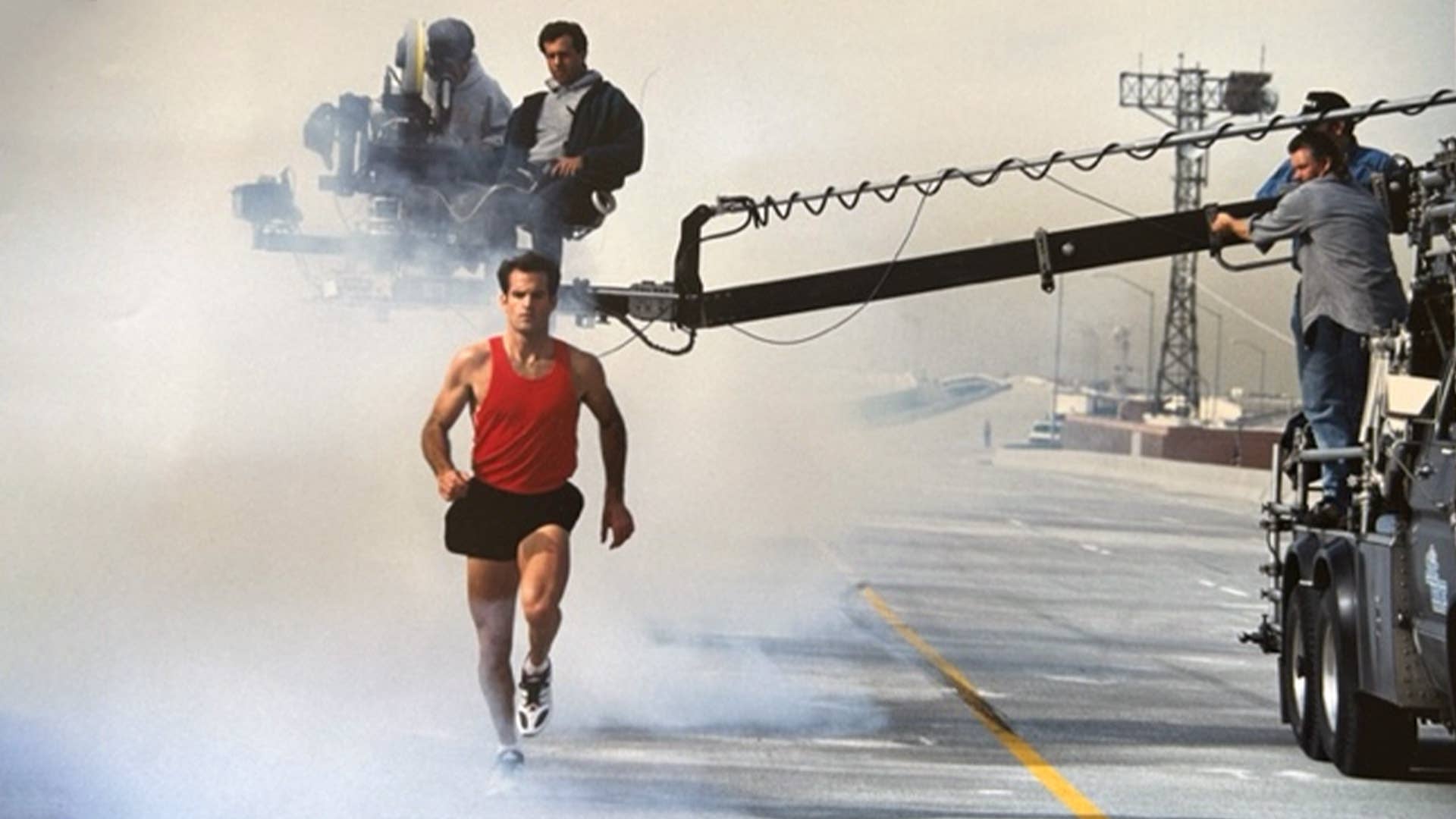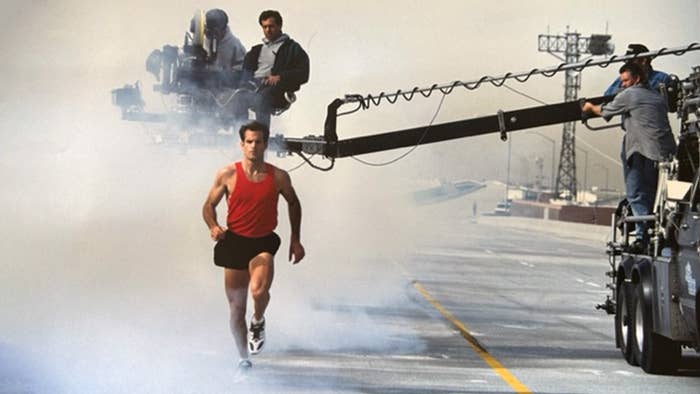
Steen Davies, a tall man with a chiseled face and quiet disposition, had spent the better part of a day suspended 20 feet above a Hollywood soundstage at the behest of Adidas and Twin Peaks director David Lynch. A crew would send Davies up on a harness while he cranked his legs in cycles, running as naturally as he could without an actual surface to run on. The kinetic energy twisted him around and upside down, spinning his axes as he churned in the air.
The gear that clutched him was not forgiving on his athletic frame; it chafed him through the acrobatic movements, rubbing his skin raw.
“This is killing me up there,” he told someone on set in between takes. A production assistant dashed off to upgrade the harness and returned 10 minutes later with a solution, stuffing it with sheepskin to better protect the actor.
Davies’ agony was practical—he was playing a marathoner battling the pain of a long-distance run. The rough grip of the harness on his floating body meant that he did not have to imagine an intense reaction.
The shoot, an ad for Adidas’ Tubular sneaker that Lynch directed in January 1993, demanded a mostly physical performance of Davies. Lynch, wearing a black longsleeve shirt and a grey cap with a bill pulled low to shield the sun from his vision, gave concise directions.
“Basically, the only thing I think I did was scream,” Davies says.
The ad, called The Wall, shows Davies running and then screaming down an abandoned highway toward an imposing wall. It shows his body working as blood pumps furiously inside his ear, then a familiar appendage in Lynch’s work. Against a palette of baked tans and melting reds, lightning cracks and spouts of flame shoot up. The titular wall explodes and the running Davies, deep red singlet and black shorts billowing around his body, floats through its rubble. It is meant to demonstrate “the emotional and physical state of a runner as he approaches his peak of exertion,” per the treatment that guided production.
Adidas’ Tubular sneaker technology, which the ad was ostensibly created to promote, does not feature prominently. The crisp white and black Tubular shoes appear most visibly at the end of The Wall. The spot was a departure for the German sportswear brand, which was fairly conservative in the early ‘90s and then focused more on print advertising. For Lynch, it was one of many advertising gigs he took on in the first half of the decade.
Although The Wall was not widely distributed in ‘93, and only earned a cult appreciation when it resurfaced online decades later, the ad is a signifier of the shifting nature of the sneaker wars in that era, when brands sought to ply their wares as culturally rich objects and not just sporting goods.
Tim Delaney, whose ad agency Leagas Delaney brought Adidas the idea to work with Lynch, feels the piece accomplished its goal of presenting the brand as an entity engaged in something more than making shoes and clothes. The only negative feedback he got was from one German exec at Adidas who thought the shots with Davies’ floating gait would not look authentic to a real runner.
“Technically, maybe his legs could be straighter but what the hell,” says Delaney. “Maybe he’s bowlegged—what do they care? They just care it’s a film by David Lynch and it looks cool. And there’s been an explosion, and they’ve seen a mouth, and they’ve seen teeth, and they’ve seen scorpions, and all hell’s broken loose.”
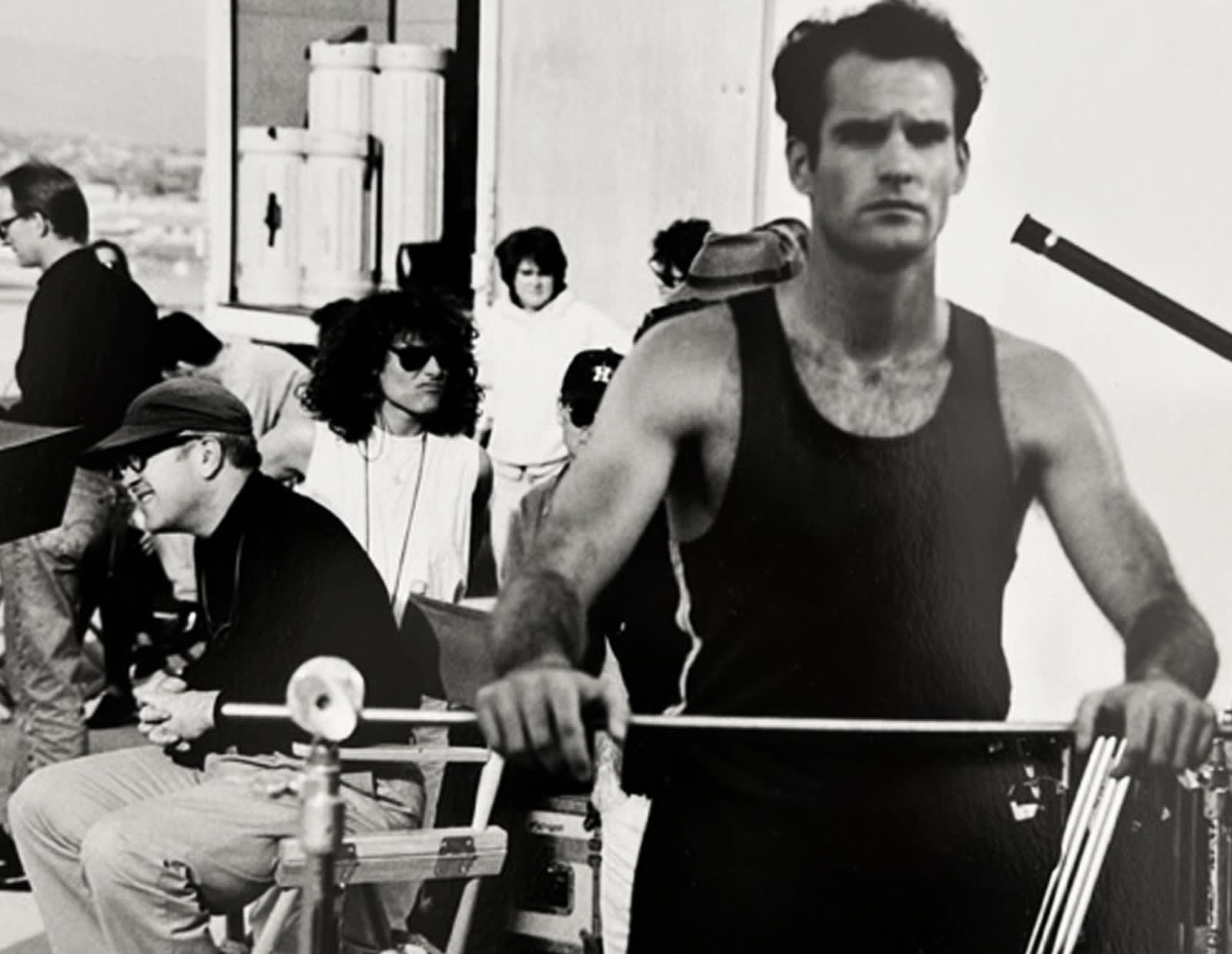
Leagas Delaney won the Adidas account in August 1992, when Delaney flew to from London to Barcelona on a 24-hour notice to pitch Adidas’ director of communications, Tom Harrington, a former Army officer who spent a year in Vietnam as a helicopter pilot.
Laney told Harrington that Adidas, which was losing relevance and facing dire financial woes, needed to appeal directly to consumers rather than trying to win them by sponsoring teams. It needed to get out of print and into film. And it needed a response to Nike, where sneakers came with an emotional connection and heroic moments thanks in part to campaigns from Wieden+Kennedy, their agency of record.
Those ads spoke of sneakers as revolutionary, and made them alluring and forbidden. They were a revelation for Steve Dunn, an art director at Leagas Delaney who worked on The Wall.
“The Wieden+Kennedy work for Nike started to filter through, and it was almost like finding the 14th musical note,” says Dunn, who went on to join Wieden+Kennedy and later founded his own agency, The Assembly. “It was like, the things they did were just off the spectrum.”
If Adidas could make its shoes as culturally resonant to young people as Nike did, it would be a victory, Delaney believed. If nothing else, it would have been better than its previous ads. Delaney cites a cheesy 30-second ad called Active Bodies produced by Young and Rubicam, Adidas’ prior agency, as a low point.
“It’s so terrifyingly corny it will make your nose bleed,” Delaney says. “It was so bad.”
Even the Adidas advertising exec Harrington, who worked at Young and Rubicam before he took over advertising at Adidas, admits that the agency did some very bad work for the brand. His firing them once he went brand side at Adidas allowed Delaney to move in and win the account.
Delaney came up with a strategy by which Adidas would make five big films in a year, with around £2.5 million allotted for their total budget. They had director Mehdi Naderi do one for Swedish tennis player Stefan Edberg where he explores other careers. Tarsem Singh directed another. They mixed in low-budget productions, like one for Adidas swimwear of a fish going ballistic, that created more room to spend elsewhere. This helped Adidas afford Lynch.
Leagas Delaney had the idea to get Lynch to make a film for Adidas that showed a runner breaking through “the wall,” which is a sense of fatigue that arrives at around the 20-mile mark of a marathon run. They wanted to show an athlete breaking through this wall, enduring the hell of intense sustained physical exertion and emerging into a heaven of euphoric joy on the other side—hence Davies pedaling his legs as he tilts skyward in the ad.
Delaney figured out how to get ahold of Lynch and sent him a one-sentence pitch: Would you be interested in doing a film for Adidas about a runner going from hell into heaven?
Lynch accepted. Adidas, through its agency, considered offering the same concept to an up-and-coming director for significantly less than Lynch’s fee, but to work with him was a statement of intent.
Dunn remembers their first meeting with the director happening in a Twin Peaks-looking room, with a set of antlers mounted on the wall. The Lynch he met and worked with on the ad was the one he was expecting: otherwordly broadcaster voice and perfect waves of salt and pepper hair. He was pleasant company, despite being hired to orchestrate hell.
“The way he looks and the way we’ve all seen him, on TV and everything else, was just the way he was in real life,” says Dunn. “There was no sense of a veneer of affectations. He was just wonderfully curious and open and oddball.”
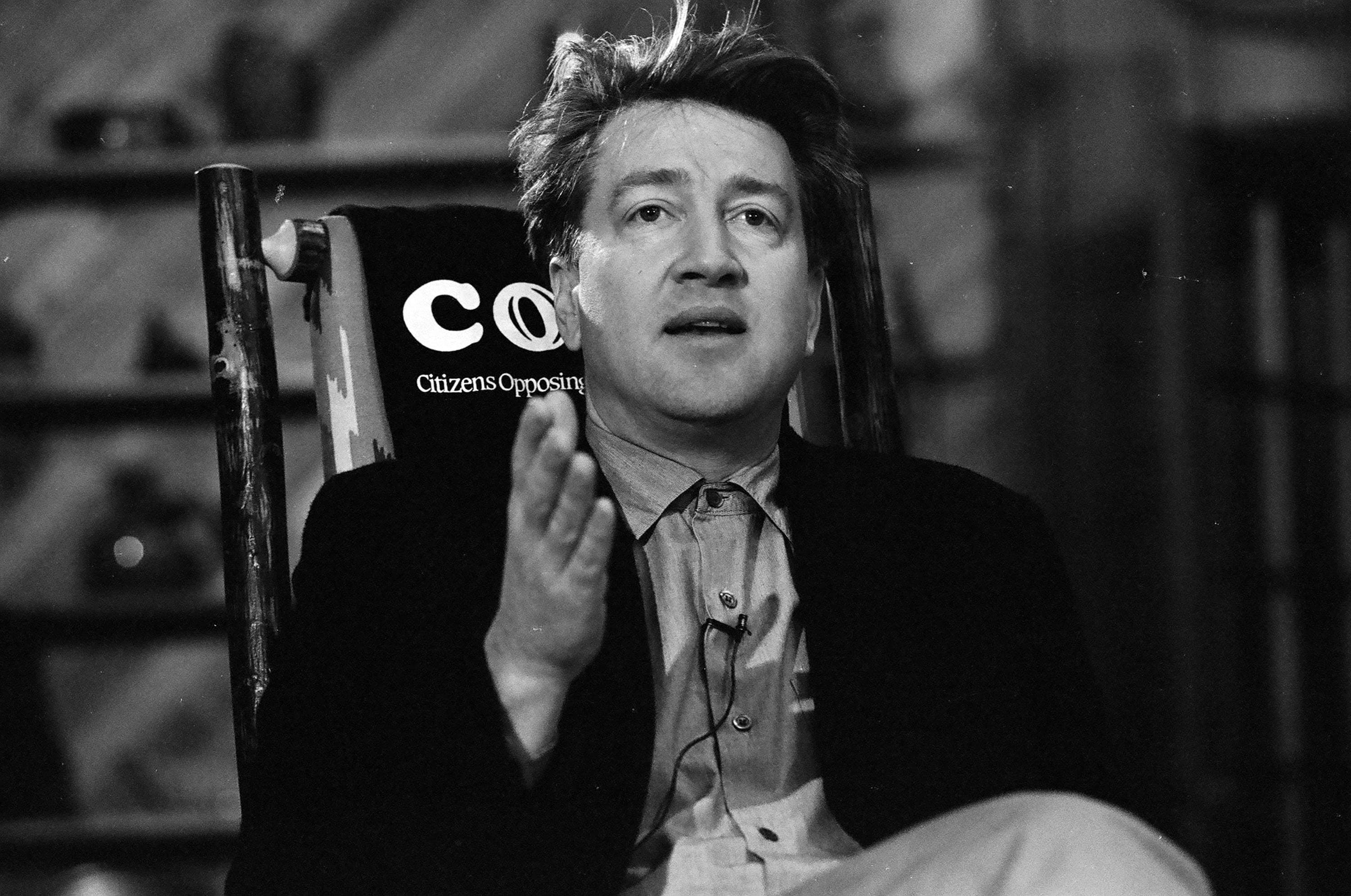
There were two locations for The Wall—the one with Davies in the harness on the soundstage and another for the exterior shots, which took place just east of LAX on the elevated 105 Freeway. The freeway was still being built, so Lynch’s crew was able to commandeer a section of it for the ad. The director needed Davies legitimately exhausted for his part, and instructed him to take off running and return in two hours.
“He wanted it to look like you’re at the end of the marathon, you’re hitting that wall, you’re hurting,” Davies remembers. “And I go, ‘No I get it, I’ve been there a million times.’”
Davies, an athlete who’d by then already done triathlons, was elated that he was essentially being paid to run around.
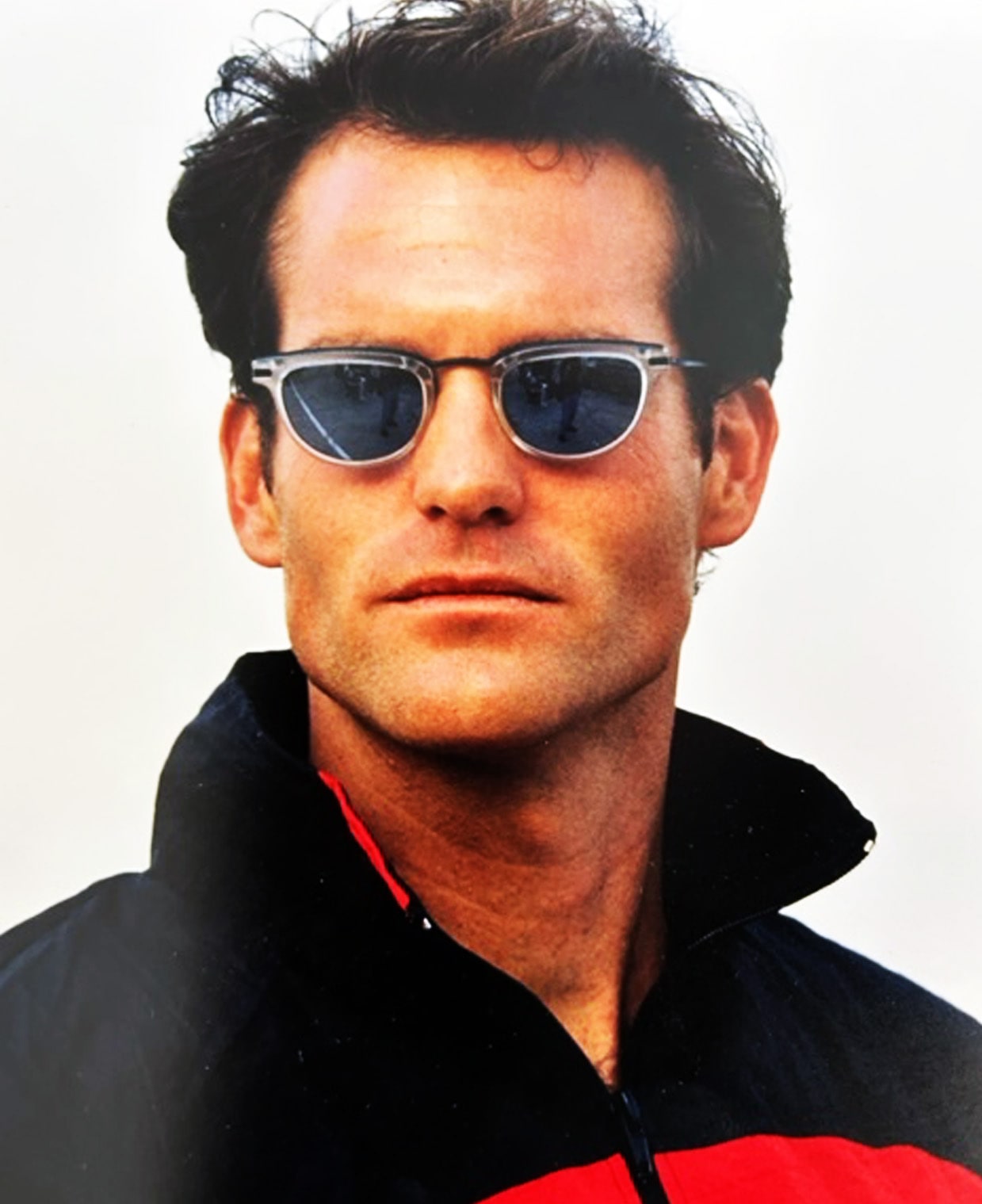
He took off down the freeway, jogging across the top of Los Angeles on the deserted road. The 105 sits above the city, which gave him a privileged vista. Other filmmakers took advantage of the setting; public transit thriller Speed shot there before the freeway opened to the public. Davies says that the Adidas production did have to share the space at one point—he remembers the FBI interrupting to run drills on a nearby building.
“They were repelling off buildings, right off the side, and then driving their rigs down, so we had to shut down for a minute while they were doing that,” Davies says. “But it was pretty cool to watch, you know, you see all these guys coming off the top of the buildings, just repelling down.”
Though the practice of contracting a movie director to make an ad was novel for Adidas when they worked with Lynch in ‘93, the brand had long been involved in the entertainment industry in Hollywood. Davies, who grew up in nearby Malibu, witnessed this firsthand.
When he was 16, a family friend named Oly Ostergard who worked at Adidas got Davies an internship in the brand’s entertainment promotions office in Los Angeles. There, he helped dress rappers, actors, and celebrities in Adidas gear. He operated alongside Angelo Anastasio and Patty Hunt, who were influential in getting the German brand’s product in big movies in the ‘80s. Harrington, who later OKed the Lynch ad, oversaw the office for a time.
Davies worked on entertainment promotions for Adidas for a few years into his late teens. He eventually became a minor face of the brand while he was in college, landing a contract around ‘89 that made him a model for Adidas’ global campaigns. (Davies had been acting and modeling since he was 14.) That job placed him in the Lynch ad, spinning above the soundstage and pumping atop the 105 Freeway toward a massive foam wall.
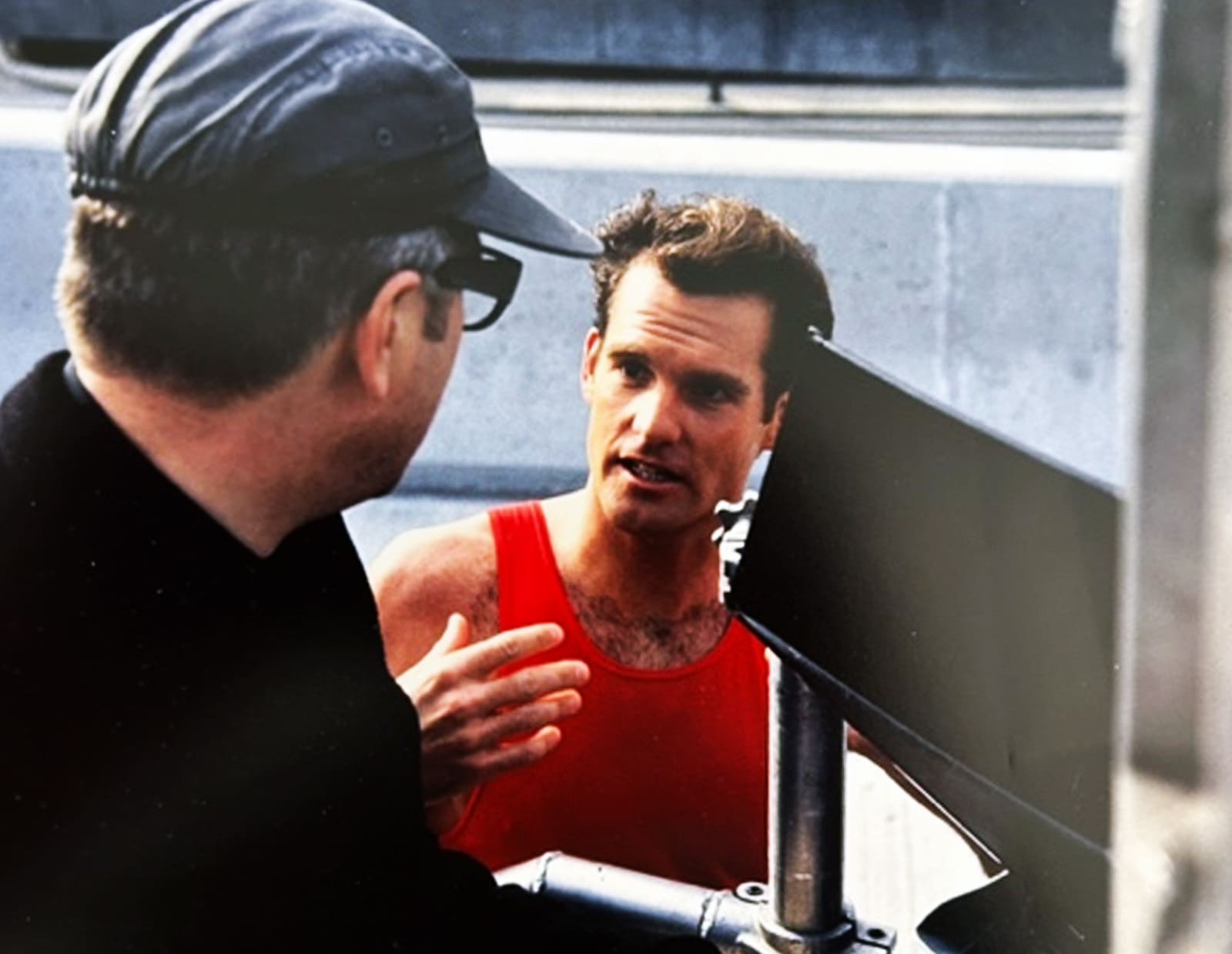
The harness Davies wore was not the only bodily discomfort the production subjected him to. There were long lenses pressed up against his ears and nose, and down into his mouth while he screamed.
“With David, there’s always an oddity for every single thing, anything you do,” says Deepak Nayar, a producer who worked on The Wall. “I mean, when we were doing the Adidas commercial, I remember he said, ‘I need scorpions.’”
Lynch sent the scorpions running down a clear plastic tube with a camera watching them. The fever dream sections of The Wall use these images and the fleshy closeups to magnify the runner’s torment: see his gaping shriek, feel his muscles sting. This is sport warped through Lynch’s vision. While the ad feels like something that could appear in one of his movies, Nayar says the director’s commercial jobs were discrete from the movies he made.
“He also understands that when he did a commercial, he needed to sell the product,” says Nayar. “This is a not a David Lynch movie.”
Not all product was eligible for his endorsement, according to Nayar, who says Lynch had a rule that he wouldn’t make ads for cigarettes or alcohol. This apparently expired by 1998, when he worked on a campaign for Swiss cigarette brand Parisienne.
Even if Lynch separated his movies from his ads, they were not distinct with respect to the personnel he used. Nayar, for example, had worked with Lynch since Twin Peaks—he started out driving the director on the show’s pilot and ascended to become a producer.
Sabrina Sutherland, who also worked on Twin Peaks and is Lynch’s current producer, was the production coordinator. The composer Angelo Badalamenti, who won a Grammy for his work scoring Twin Peaks, did the music for The Wall. (Delaney recalls seeing him shuffling around the production office draped in a cardigan.) Special effects coordinator Gary D’Amico met Lynch on the second season of Twin Peaks. For The Wall, he was in charge of building the 20-by-40-foot foam structure on the 105, loading it with det cord explosives, and blasting it open for the spot’s climax. Some of those who worked on the commercial recall that Lynch’s ex-wife and longtime editor Mary Sweeney edited it, but a rep for Sweeney says this wasn’t the case. Even Davies enjoyed a tenuous membership in Lynch’s extended crew—he says he was later a production assistant on Lost Highway and appeared in a scene that didn’t make the final cut.
The production did not feature any representation from Adidas. Delaney enjoyed a relative amount of autonomy from his client—Harrington trusted him enough to not show up to the shoot and fret about how the sneaker company would look. Nayar says that there was never a real relationship between Adidas and Lynch, who interfaced with the agency rather than the brand. Still, he was conscientious and respectful of the fact that he was working for a brand.
“Commercials for him was sort of so removed from what he was trying to do at that time,” Nayar says. “I think sometimes you do these things as a matter of taking your mind away from something else.”
The commercial work was a steady stream of income for Lynch. The Wall came at a time when he was busy, but not with regular projects from big film studios. It’s possible the structures those come with weren’t totally comfortable for him, especially after the disaster of Dune in 1984, which he called “a horrible sadness and failure.” While he wasn’t making many feature films in the first half of the ‘90s, he was prolific in his advertisements.
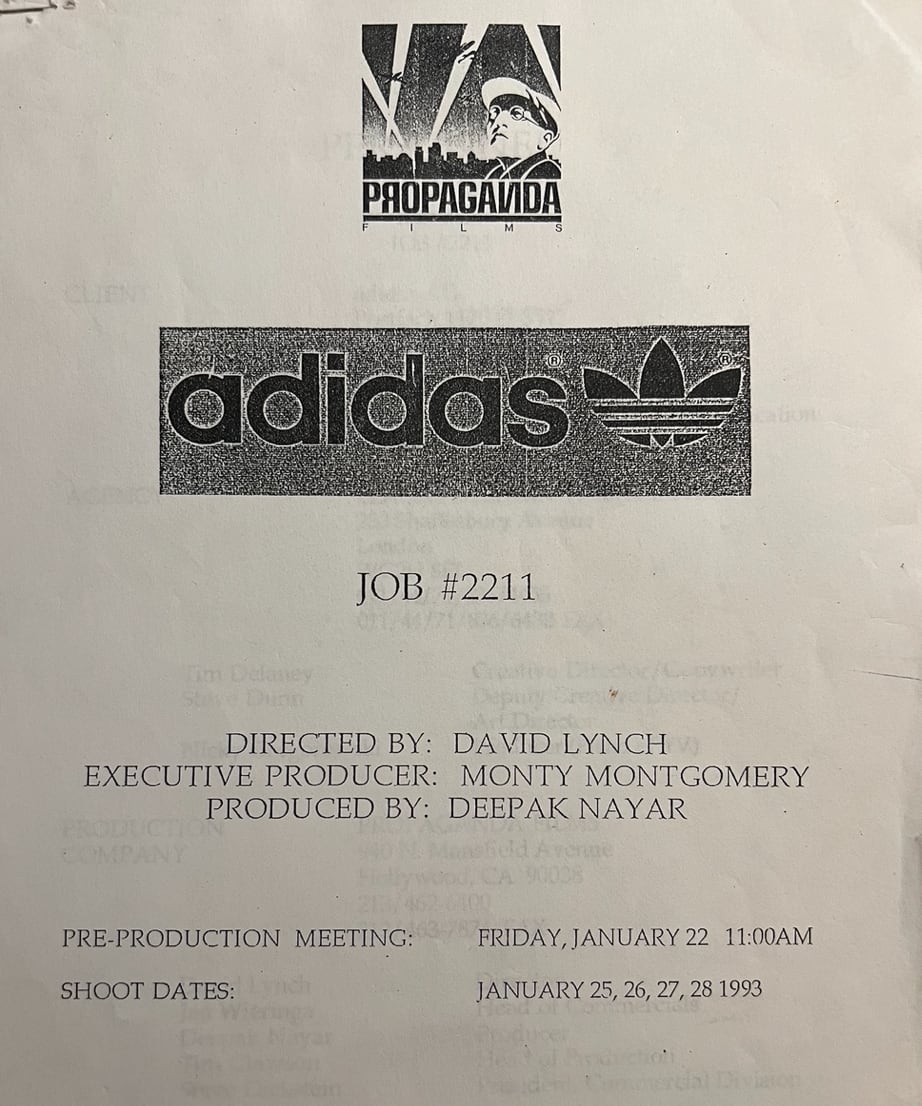
There are slightly dissenting memories of what Lynch’s fee was for The Wall, but those who contributed to the Adidas ad agree that it cost around $1 million total to make. Nayar says that number was more than Lynch himself would have made off the spot. Delaney says that Lynch would have gotten around $200,000 to direct, with the rest of the money going toward the budget.
Harrington, who approved the spend from Adidas, distinctly remembers the total cost being around $1 million. It was a sizable investment for the sneaker brand.
“You have to understand the mentality of a German company that’d never done any advertising,” Harrington says. “To spend a million dollars for a director of a commercial when we were spending $200,000 was a lot for Adidas to spend on advertising.”
For all its costs, The Wall was not widely distributed. No matter how much Harrington believed in the work, he didn’t control where it would run. This is partly because of Adidas’ structure at the time, which had global subsidiaries representing the brand in different territories.
“It wasn’t shown much,” he says. “I can’t give you the numbers, I don’t know, but I can guarantee you it was not shown much.”

There was no great splash to accompany the work, no matter how groundbreaking it may have been for Adidas. When David Foster Wallace recounted Lynch’s prolificacy of that era in his 1996 essay David Lynch Keeps His Head, the Adidas advertisement was not mentioned. Davies, who was used to having family call to say they’d seen him in an ad, never had anyone in the US say they spotted him in The Wall, but he did hear from people in Europe about it.
For anyone not obsessed with sportswear, the crossover between Adidas and David Lynch doesn’t amount to much more than a footnote in his filmography. The advertisement certainly didn’t ignite a buzz around the Tubular sneakers in the way that Nike commercials at the time were creating cult passion around Air Jordans and Air Max running shoes. But it did leave a mark—Dunn saw this firsthand when he switched sides and went to work on Nike campaigns for Wieden+Kennedy. There, The Wall preceded him.
“When I got there,” he says, “everyone was just freaked out by the ad. Because as much as Wieden+Kennedy introduced a completely new vocabulary for commercials and advertising, I think the Adidas work came from an angle even they couldn’t suspect would happen. It really was a jolt. People would come to me and say, ‘Have you seen this?’ I would say, ‘Yeah, I did it.’”

